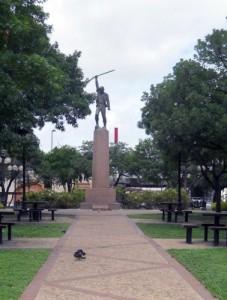Okay, do I start with Benjamin Milam or with the cemetery? :flips coin:
I literally did just flip a coin there, and it came up tails, so the cemetery it is.
In the 1850s, there were two graveyards in the area near the intersection of Houston and Santa Rosa Streets. On one side of the line which is now Houston Street (underneath where the Children’s Hospital of San Antonio is today) was the Catholic cemetery. On the other side of that line was a public cemetery for non-Catholic burials.
After only a few years, the number of dead in the public cemetery became too great for the small plot of land and all of the bodies there, except, to our knowledge, one, were moved to other cemeteries. That one body belonged to Ben Milam.
Benjamin Rush (Ben) Milam was born in 1788. In the early 1800s he moved to Texas and when the war for Texas Independence began, he is claimed to have called for recruits to take the town of San Antonio by calling out “Who will go with old Ben Milam into San Antonio?” In one version of the tale, he is said to have drawn a line in the dirt on the ground with a stick in his hand. This will be important later.
Milam was killed during the Siege of San Antonio by a gunshot to the head. He was on his way to the “Veremendi Palace, which the house gained the title “Palace” because it had been home to one of the governors of Coahuila y Tejas. The Veremendi Palace was on Soledad Street not too far from Main Plaza. Milam’s body was buried in the yard of the house originally and later his body was exhumed and moved to the public cemetery.
Once his body was interred in the public cemetery, a marble marker was placed over the spot. Later that marker was removed and replaced by a granite monument, which was originally supposed to have been surmounted by a statue. They never put the statue on the monument. 34 years after Milam’s burial, they turned the land into a park and named the park for Milam. In 1938, the Texas Centennial Commission put a statue of Ben Milam holding a rifle aloft in his right hand on the west edge of the park. Over the intervening decades, the knowledge that the granite monument was a gravestone was lost and, in 1976, the marker was moved as part of a park beautification project.

In 1993, the city began renovations on the park and the workers found a skeleton under a concrete slab. The slab was near the center of the park and was just little larger than the size of the granite monument. Since the granite monument was heavy and had originally been planned to be even heavier, the archaeologists who were monitoring the project decided that the concrete slab may have been the original foundation for the granite monument. If that were true, the skeleton had a good chance of being Milam’s remains. They exhumed the body and took it to the Center for Archaeological Research at the University of Texas at San Antonio.
The remains were of a man of about Milam’s height who was about Milam’s age at death. Only fragments of skull were found, but they had markings consistent with having been killed by a gunshot to the head. Remember the stick in Milam’s hand up there? In that tale, he didn’t pick it up from anywhere, it just sort of was in his hand. The body was found to have belonged to someone with arthritis in his legs and back, and, well, a cane is, in fact, a stick that you hold in your hand.
Remember that that land was only a cemetery for a few years. The odds of another body having been placed beneath a concrete slab the size of the grave marker for Milam during those few years are slim. Add to that the fact that the body found was a male the same height as Milam makes the chance that it’s anyone else slimmer. That plot of land was a cemetery decades before the era of the old west gunfight (and San Antonio hasn’t been so much “western United States” as “northern Mexico”). Most of the bodies in the cemetery had died of things like cholera and old age. As a result, the bullet wound to the head makes it nearly certain that the skeleton belongs to Milam.
The body was re-interred under the statue in Milam Park in 1994.
Milam Park is a nice little (emphasis on “little”) park. From what I can tell, it is around four acres in area and, in addition to Milam’s grave, has a playground, a gazebo, picnic tables, and a quarter of a mile of walking trails. As with most other urban parks, Milam Park looks pretty wheelchair accessible. The park is all level and paved and there are curb cuts.
Reference:
Exhumation of a Hero, Colonel Ben Milam: Milam Park Renovation, Phase I, Cynthia L. Tennis, Center for Archeological Research, University of Texas at San Antonio, 1995
